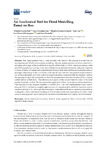| dc.contributor.author | García-Feal, Orlando | |
| dc.contributor.author | González-Cao, José | |
| dc.contributor.author | Gómez-Gesteira, Moncho | |
| dc.contributor.author | Cea, Luis | |
| dc.contributor.author | Domínguez, J. M. | |
| dc.contributor.author | Formella, Arno | |
| dc.date.accessioned | 2018-12-03T18:20:44Z | |
| dc.date.available | 2018-12-03T18:20:44Z | |
| dc.date.issued | 2018 | |
| dc.identifier.citation | García-Feal, O.; González-Cao, J.; Gómez-Gesteira, M.; Cea, L.; Domínguez, J.M.; Formella, A. An Accelerated Tool for Flood Modelling Based on Iber. Water 2018, 10, 1459. | es_ES |
| dc.identifier.issn | 2073-4441 | |
| dc.identifier.uri | http://hdl.handle.net/2183/21431 | |
| dc.description | Este artigo inclúese no número especial "Selected Papers from the 1st International Electronic Conference on the Hydrological Cycle (ChyCle-2017)" | es_ES |
| dc.description.abstract | [Abstract:] This paper presents Iber+, a new parallel code based on the numerical model Iber for two-dimensional (2D) flood inundation modelling. The new implementation, which is coded in C++ and takes advantage of the parallelization functionalities both on CPUs (central processing units) and GPUs (graphics processing units), was validated using different benchmark cases and compared, in terms of numerical output and computational efficiency, with other well-known hydraulic software packages. Depending on the complexity of the specific test case, the new parallel implementation can achieve speedups up to two orders of magnitude when compared with the standard version. The speedup is especially remarkable for the GPU parallelization that uses Nvidia CUDA (compute unified device architecture). The efficiency is as good as the one provided by some of the most popular hydraulic models. We also present the application of Iber+ to model an extreme flash flood that took place in the Spanish Pyrenees in October 2012. The new implementation was used to simulate 24 h of real time in roughly eight minutes of computing time, while the standard version needed more than 15 h. This huge improvement in computational efficiency opens up the possibility of using the code for real-time forecasting of flood events in early-warning systems, in order to help decision making under hazardous events that need a fast intervention to deploy countermeasures. | es_ES |
| dc.description.sponsorship | Water JPI—WaterWorks Programme, project Improving
Drought and Flood Early Warning, Forecasting and Mitigation, IMDROFLOOD; PCIN-2015-243 | es_ES |
| dc.description.sponsorship | European Commission; project RISC_ML 034_RISC_ML_6_E | es_ES |
| dc.description.sponsorship | Xunta de Galicia; ED431C 2017/64-GRC | es_ES |
| dc.description.sponsorship | Xunta de Galicia; ED481A-2017/314 | |
| dc.description.sponsorship | Xunta de Galicia; ED481B-2018/020 | |
| dc.description.sponsorship | European Commission; IMDROFLOOD PCIN-2015-243 | |
| dc.language.iso | eng | es_ES |
| dc.publisher | MDPI | es_ES |
| dc.relation.uri | https://doi.org/10.3390/w10101459 | es_ES |
| dc.rights | Atribución 3.0 España | es_ES |
| dc.rights.uri | http://creativecommons.org/licenses/by/3.0/es/ | * |
| dc.subject | Flood | es_ES |
| dc.subject | Numerical simulation | es_ES |
| dc.subject | Shallow water equations | es_ES |
| dc.subject | Iber+ | es_ES |
| dc.subject | Benchmark | es_ES |
| dc.subject | CUDA | es_ES |
| dc.subject | OpenMP | es_ES |
| dc.subject | Finite volume | es_ES |
| dc.title | An accelerated tool for flood modelling based on Iber | es_ES |
| dc.type | info:eu-repo/semantics/article | es_ES |
| dc.rights.access | info:eu-repo/semantics/openAccess | es_ES |
| UDC.journalTitle | Water | es_ES |
| UDC.volume | 10 | es_ES |
| UDC.issue | 10 | es_ES |
| UDC.startPage | 1 | es_ES |
| UDC.endPage | 23 | es_ES |
| dc.identifier.doi | https://doi.org/10.3390/w10101459 | |






